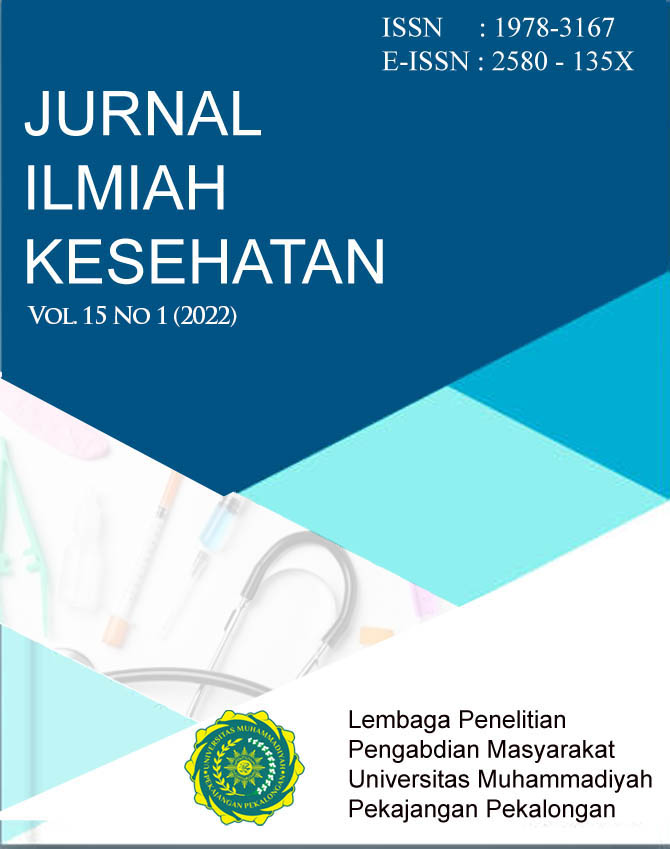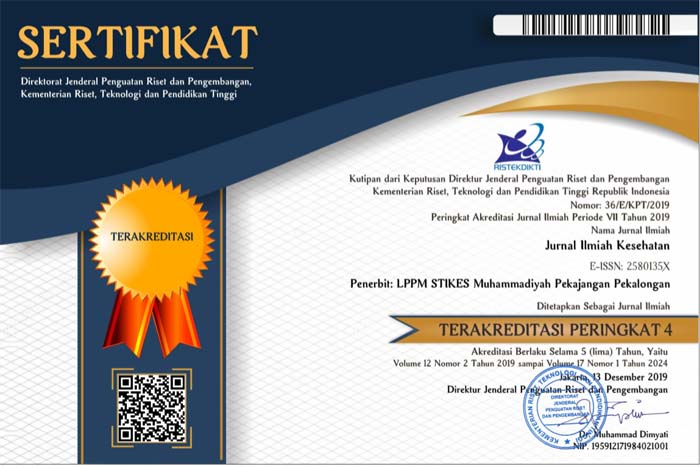Efektivitas Penghambatan Enzim Xantin Oksidase Ekstrak Etanol Dan Fraksi Etanol, Fraks Etil Asetat Serta Fraksi N-Heksane Kulit Batang Mangrove Merah (Rhizopora Mucronata)
DOI:
https://doi.org/10.48144/jiks.v15i1.869Keywords:
Rhizophora mucronata, Xanthine oxidase, Antihyperuricemia, FractionAbstract
Hyperuresmia is an increase in serum uric acid levels above the normal limit (7.0 mg/dL for men and 6.0 mg/dL for women). Hyperuresmia at an advanced stage can cause gout or gout (a disease that attacks the joints and causes joint damage), kidney stones, kidney damage, and hypertension. One of the types of mangrove plants in Indonesia is the red mangrove (Rhizopora mucronata). Utilization of red mangrove as a traditional medicine has long been used as a medicine for sprains, diarrhea, dysentery, blood urine, fever, angina, diabetes, hematuria, stopping bleeding, coughing, inflammation and rheumatism. Rhizophora mucronata contains secondary metabolites of the phenol group, tannins, flavonoids, saponins, glucosides, terpenoids, and alkaloids. The purpose of this study was to determine the inhibitory activity of xanthine oxidase ethanol extract and bark fraction of red mangrove (Rhizopora mucronata) in vitro. The research process begins with the extraction of the bark of the red mangrove (Rhizopora mucronata) with 96% ethanol, then the process of fractionation using the liquid-liquid partition method with a separating funnel. Testing the activity of xanthine oxidase inhibition in vitro using a UV/VIS spectrophotometer. The results showed that the ethanol extract, ethanol fraction, ethyl acetate fraction and hexane fraction showed inhibitory activity of the xanthine oxidase enzyme with IC50 values of 197,558 ± 20,862; 58,755 ± 3,821; 38,543 ± 1,440 and 210,213 ± 15,577 ppm. From the results of the study, it can be concluded that the ethanol extract and bark fraction of red mangrove (Rhizopora mucronata) can inhibit the activity of the xanthine oxidase enzyme with the ethyl acetate fraction providing the highest inhibitory activity with an IC50 value of ; 38,543 ± 1,440 ppm
References
P. Fang, X. Li, J. J. Luo, H. Wang, and X. Yang, “A double-edged sword: uric acid and neurological disorders,” Brain Disord. Ther., vol. 2, no. 2, p. 109, 2013.
R. Juwita, C. Saleh, and S. Sitorus, “Uji aktivitas antihiperurisemia dari daun hijau tanaman pucuk merah (Syzygium myrtifolium walp.) terhadap mencit jantan (Mus musculus),” J. At., vol. 2, no. 1, pp. 162–168, 2017.
N. Dalbeth, T. J. Lauterio, and H. R. Wolfe, “Mechanism of action of colchicine in the treatment of gout,” Clin. Ther., vol. 36, no. 10, pp. 1465–1479, 2014.
S. H. Nile, B. Kumar, and S. W. Park, “In vitro evaluation of selected benzimidazole derivatives as an antioxidant and xanthine oxidase inhibitors,” Chem. Biol. Drug Des., vol. 82, no. 3, pp. 290–295, 2013.
F. Cendrianti, S. Muslichah, and E. U. Ulfa, “Uji aktivitas antihiperurisemia ekstrak n-heksana, etil asetat, dan etanol 70% daun tempuyung (Sonchus arvensis L.) pada mencit jantan hiperurisemia,” Pustaka Kesehat., vol. 2, no. 2, pp. 205–210, 2014.
G. K. Chinnaboina, A. M. S. S. Babu, R. Verma, P. Sharma, and B. Shrivastava, “Pharmacological evaluation of ethanolic extract of Rhizophora mucronata flower against streptozotocin-induced diabetic nephropathy in experimental animals,” J. Pharmacogn. Phytochem., vol. 7, no. 5, pp. 381–387, 2018.
P. Thirunavukkarasu, S. Asha, R. Reddy, D. Priya, R. Hari, and N. Sudhakar, “Phytochemical analysis of medicinal mangrove plant species Ceriops decandra,” Glob. J. Pharmacol., vol. 12, no. 1, pp. 24–30, 2018.
P. A. L. Pacher, A. Nivorozhkin, and C. Szabó, “Therapeutic effects of xanthine oxidase inhibitors: renaissance half a century after the discovery of allopurinol,” Pharmacol. Rev., vol. 58, no. 1, pp. 87–114, 2006.
D. E. C. Van Hoorn et al., “Accurate prediction of xanthine oxidase inhibition based on the structure of flavonoids,” Eur. J. Pharmacol., vol. 451, no. 2, pp. 111–118, 2002.












